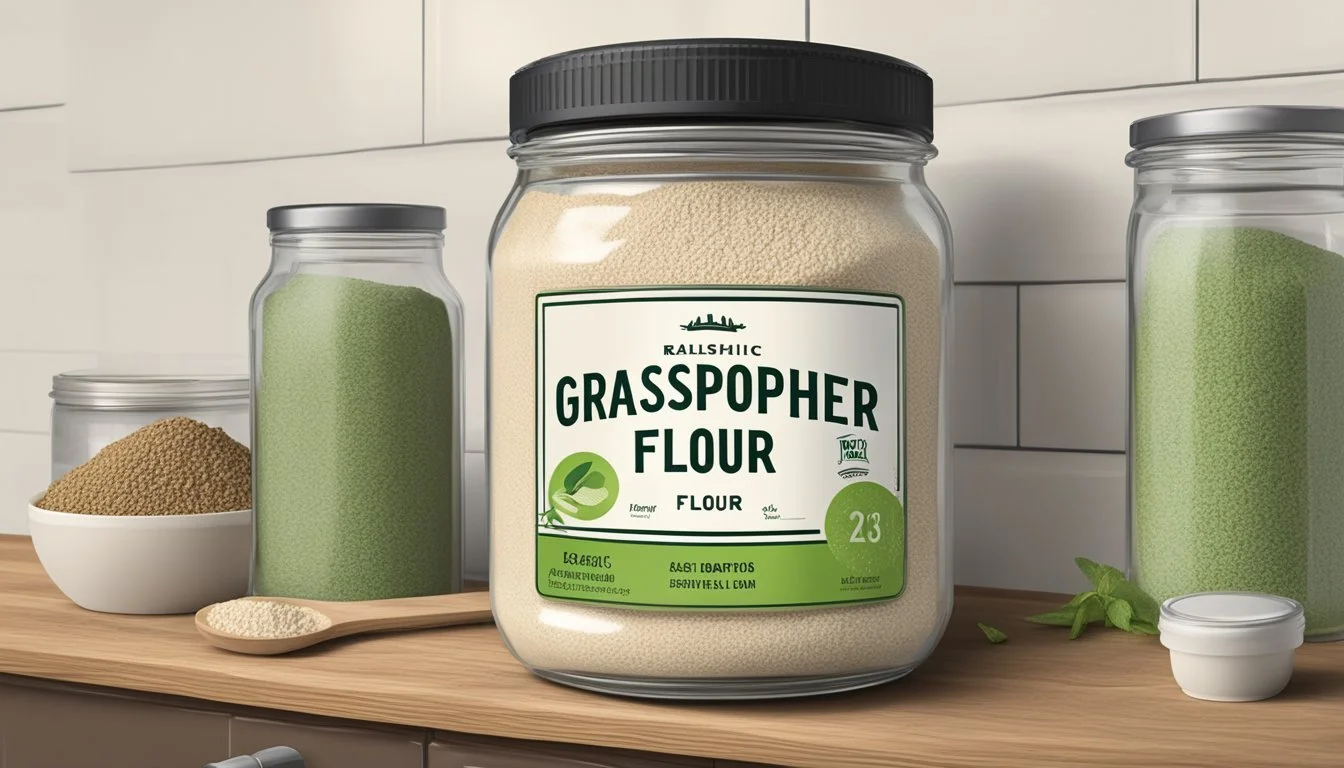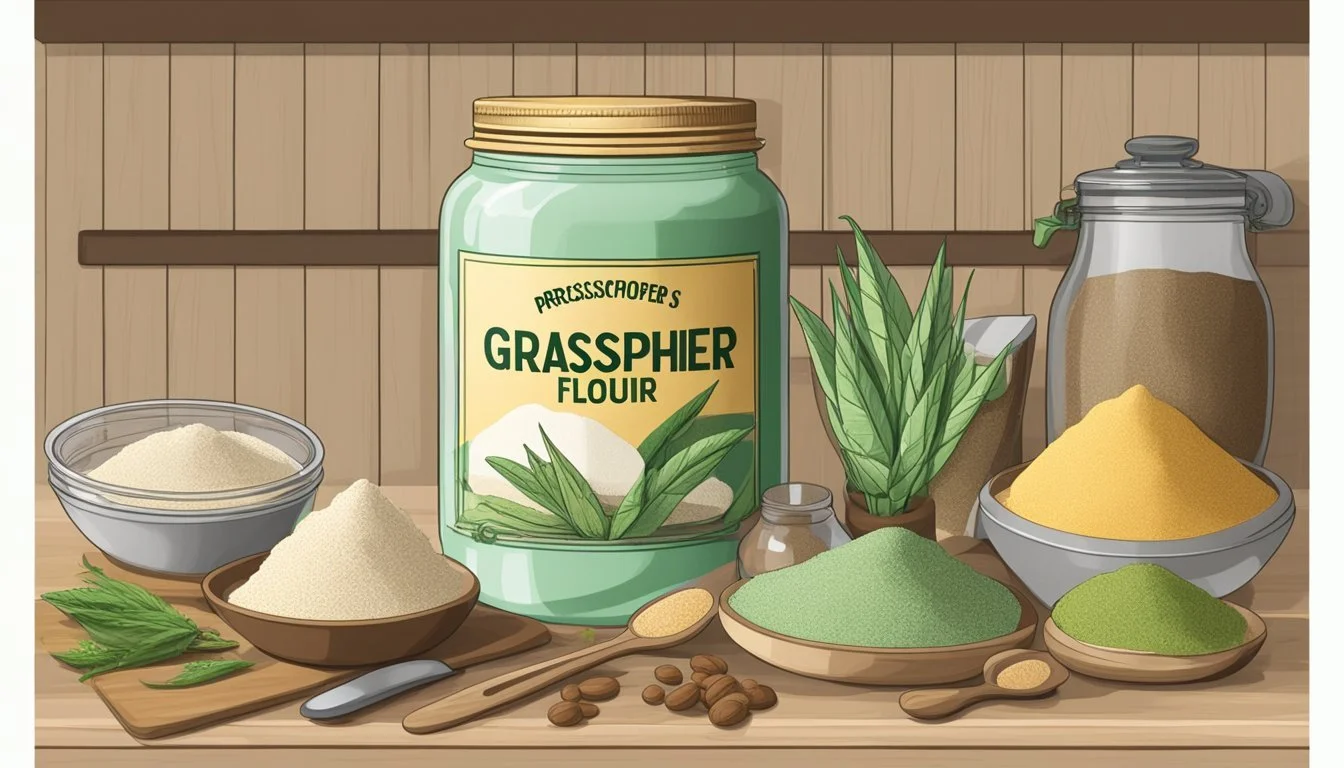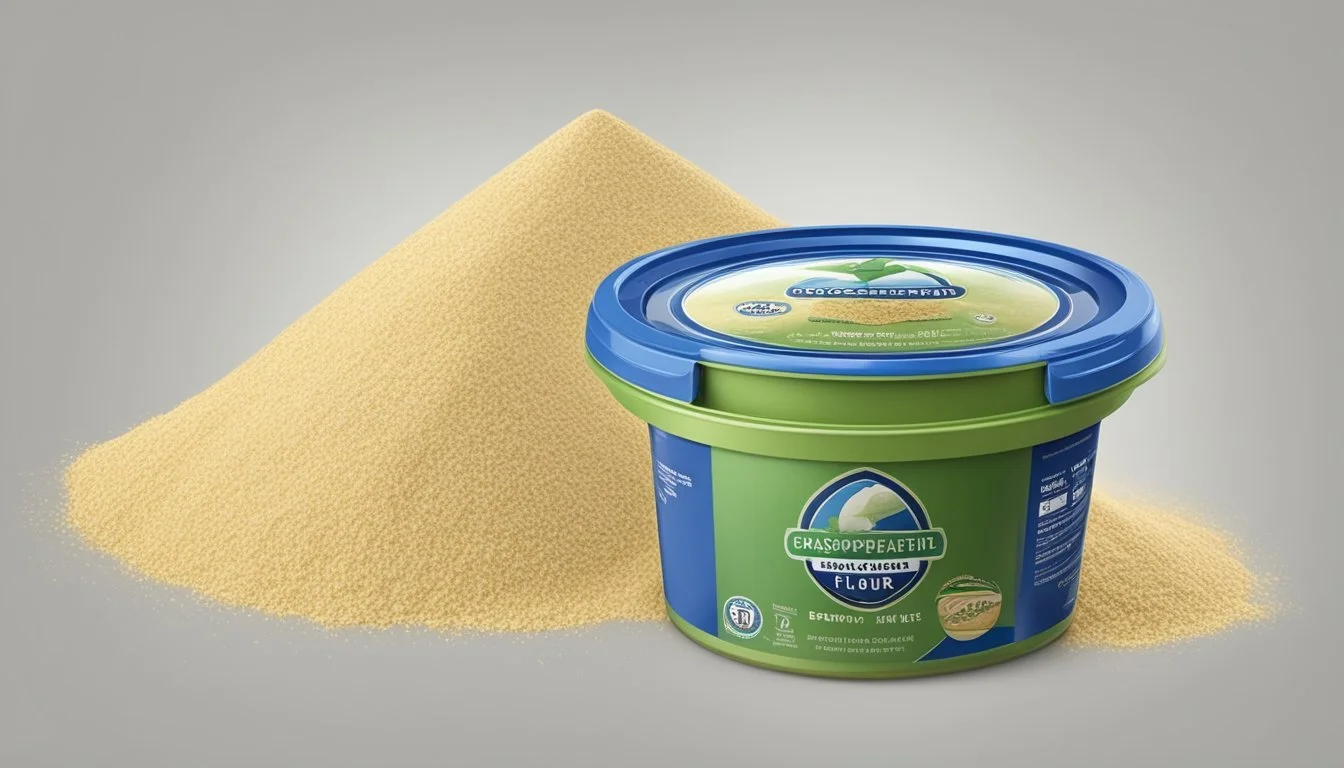How Long Does Grasshopper Flour Last?
Shelf Life and Storage Tips
Grasshopper flour, also known as cricket flour, is a sustainable protein source gaining popularity in health and fitness circles for its nutritional benefits. Unlike traditional grain-based flours, grasshopper flour is made from milled grasshoppers and provides a gluten-free alternative rich in protein. Due to its unique composition, it differs significantly from other flours in terms of storage and shelf life.
The longevity of grasshopper flour depends on several factors including storage methods and environmental conditions. When stored properly in an airtight container, away from heat and moisture, it can maintain its quality for a substantial period. It is important to note that shelf life can vary, and one should always assess the flour for any signs of spoilage such as off smells or changes in texture before use.
For those incorporating grasshopper flour into their diet, understanding proper storage is key to extending its freshness. Keeping it refrigerated or even frozen can help preserve its integrity for a longer time, ensuring that the nutritional qualities are retained. When considering the use of grasshopper flour, it is essential to follow storage recommendations and inspect the flour's quality periodically.
Understanding Flour and Its Components
Flour is more complex than it may appear. It can come from a variety of grains or seeds, each with specific properties due to their unique composition.
Exploring Different Types of Flour
There are numerous types of flour used in baking and cooking. These types are categorized based on the source grain and the processing methods used to produce them:
All-purpose flour: A blend of hard and soft wheat; versatile and widely used.
White flour: Milled from wheat after removing the bran and germ, resulting in a finer texture.
Whole wheat flour: Made from the entire kernel, including bran, germ, and endosperm.
Whole grain flour: Similar to whole wheat, but can include other grains like oats or barley.
Nut flour (e.g., almond flour, coconut flour): Ground from nuts; rich in fats, gluten-free.
Buckwheat flour: Despite the name, it is gluten-free and made from a plant related to rhubarb.
Cake flour: Milled to a fine consistency and lower in protein for tender baked goods.
Gluten-free flour: A combination of non-wheat flours suitable for gluten intolerance.
The Role of Moisture and Fat Content
Moisture and fat content are critical in determining the shelf life and suitability of flour for various recipes:
Moisture levels: Affect flour's longevity; drier flours tend to last longer.
Fat content: Higher in nut flours; may cause them to spoil more quickly. For example, almond flour has a higher fat content than all-purpose flour, making it more perishable.
Flour's components, like bran, germ, and gluten, also influence its behavior in cooking and baking. The germ is the nutrient-rich embryo of the grain, which can increase fat content, while bran, the outer layer, adds fiber. Gluten, a protein found in wheat flours, gives elasticity and strength to doughs made with such flours.
Shelf Life of Grasshopper Flour
Grasshopper flour, an alternative type of flour made from insects, has a distinctive shelf life that differs from traditional grain-based flours. Understanding the factors that influence its longevity and the signs of spoilage is crucial for safe consumption.
Factors Affecting Flour Longevity
Storage Conditions: The environment where grasshopper flour is stored significantly impacts its shelf life. For optimal preservation, it should be stored in a cool, dry place away from direct sunlight. Humidity can contribute to spoilage, so an airtight container is recommended to protect it from moisture and pests.
Temperature: Freezing grasshopper flour can extend its shelf life considerably. Keeping it in the freezer in a well-sealed container can maintain its quality for several months.
Expiration Dates: It’s crucial to note the best-by date or any expiration date on the packaging, as these provide a guideline for the expected shelf life under ideal conditions.
Identifying Signs of Spoilage
Odor: A change in smell is a primary indicator of spoilage. If the flour emits a rancid or musty odor, it should be discarded.
Appearance: The flour should retain its natural color. Any signs of yellowing or mold growth indicate spoilage.
Texture: Grasshopper flour should have a consistent, fine texture. The presence of clumping suggests that moisture has entered the flour and can lead to spoilage.
Consumers should trust their senses and inspect grasshopper flour before use, discarding any flour that exhibits these spoilage signs.
Proper Storage Techniques
Proper storage of grasshopper flour extends its shelf life and maintains quality. The following subsections outline optimal conditions and common mistakes to avoid.
Optimal Storage Conditions
Grasshopper flour, like other flours, retains its quality best when stored in an airtight container. This type of packaging minimizes exposure to air and humidity, which can degrade the flour over time. For prolonged freshness, one should opt for a cool, dry, and dark place. Storing grasshopper flour in the freezer can significantly extend its shelf life, making it a suitable option for long-term storage. Here is how one should store grasshopper flour properly:
Temperature: Keep it below 77°F (25°C) to avoid the onset of rancidity.
Light: Store in a cupboard or pantry away from direct light which can degrade its quality.
Moisture: Ensure the storage environment is arid to prevent clumping and spoilage.
Container: Utilize glass jars or plastic bags that can be sealed airtight.
Freezer: For extending shelf life beyond a few months, place the airtight container in the freezer.
Avoiding Common Storage Mistakes
When it comes to preserving grasshopper flour, certain practices can unintentionally shorten its lifespan. It’s important to avoid these pitfalls:
Non-Airtight Packaging: Flour stored in the packaging it came in is often not sufficient for long-term protection.
Excessive Heat: Keeping flour near heat sources like the stove or in a warm environment will hasten deterioration.
Moist Environments: Bathrooms and refrigerators can harbor humidity which is harmful to flour quality.
Inconsistent Storage: Frequently shifting flour from cold to warm environments can cause condensation, adversely affecting the flour.
By adhering to these guidelines, one ensures that their grasshopper flour stays fresh and usable for as long as possible.
Maximizing Flour Freshness and Safety
Ensuring that grasshopper flour remains fresh and safe for consumption involves regular quality checks and knowing when to discard the product to prevent food safety hazards such as rancidity, mycotoxins, and infestation by pests like weevils and bugs.
Checking for Quality and Safety
To maintain the freshness of grasshopper flour, consumers should store it in a cool, dry place, ideally in an airtight container. They must check for:
Color and Smell: Fresh grasshopper flour should have a consistent color and a neutral or slightly nutty smell. Any changes might indicate spoilage or the onset of rancidity.
Texture: The flour should be free-flowing and not clump together, which could be a sign of moisture exposure or insect contamination.
Regular inspections for insects, such as weevils or other bugs, are crucial. Infestation often occurs when flour is not stored properly and can lead to both food waste and potential health hazards.
When to Discard Flour
Grasshopper flour needs to be discarded if it shows signs of:
Rancidity: An off smell or taste indicates that the flour's fats have begun to oxidize, compromising its safety and quality.
Mycotoxins: These harmful substances can form when flour is improperly stored, especially in warm, humid conditions, leading to potential health risks.
Infestation: The presence of insects or their larvae in the flour is a clear signal that the flour is not safe to use.
The following checklist can help determine if grasshopper flour should be discarded:
Odd or stale odor: Yes / No
Clumping or changed texture: Yes / No
Visible signs of insects or larvae: Yes / No
Past the expiration date or noticeably changed qualities: Yes / No
If any of the above checks result in a "Yes," the flour should not be used and ought to be disposed of properly to prevent further contamination or food waste.
Utilizing Grasshopper Flour in Baking
Bakers often seek out grasshopper flour for its unique flavor and nutritional profile. When baking, it's crucial to understand how to incorporate it into recipes correctly and to be mindful of its shelf life to ensure the best results.
Incorporating Flour in Recipes
Grasshopper flour can add a distinct taste and texture to baked goods. When one is incorporating grasshopper flour into recipes, it should be done so with consideration for its density and flavor:
Replacement Ratio: Replace up to 25% of traditional flour with grasshopper flour to maintain structure.
Hydration: It may require adjusting liquids, as it can absorb more moisture.
Mixing: To avoid overworking the dough, mix until just combined.
Flavor Pairing: Complement its earthy notes with chocolate or spices like cinnamon.
Effects of Aging on Baking Outcomes
The age of grasshopper flour can significantly influence the flavor and leavening of baked goods:
Leavening Agents: Fresh grasshopper flour reacts predictably with baking powder; aging diminishes this reaction.
Flavor: Over time, the flour can develop off-flavors, which can alter the desired outcome.
Expiration Date: Always check the expiration date; flour past its date may not yield optimal baking results.
Storage: Store in a cool, dry place or freeze to extend its baking efficacy.
Baking with grasshopper flour introduces a unique element to recipes, but it requires attention to detail to achieve the desired consistency and taste in the final product.
Extended Preservation Methods
When preserving grasshopper flour for extended periods, controlling factors such as temperature and moisture is crucial. Methods like freezing can significantly extend shelf life, while the use of preservatives and additives can also contribute to flour longevity by inhibiting spoilage.
Freezing Flour for Longevity
Freezing grasshopper flour is an effective way to extend its shelf life. By placing the flour in airtight containers or freezer bags, one can minimize exposure to oxygen and moisture. The ideal procedures for freezing grasshopper flour include:
Temperature: Keep the freezer at a consistent 0°F (-18°C) to inhibit the development of any spoilage organisms.
Moisture Control: Use airtight containers or quality freezer bags to prevent the flour from absorbing moisture and odors from the freezer.
Steps for Freezing:
Place grasshopper flour in airtight containers or freezer bags.
Label the containers with the date of freezing.
Store the flour in the coldest part of the freezer, away from the door.
By following these steps, grasshopper flour can maintain its quality for up to six months in the freezer.
Using Preservatives and Additives
Additives and preservatives can play a role in extending the shelf life of grasshopper flour by reducing the degrading effects of oxygen and moisture. These substances are often food-grade and are designed to preserve freshness and prevent the growth of microorganisms. Notable preservatives include:
Oxygen Scavengers: Help in maintaining the flour's freshness by reducing the oxidation process.
Moisture Inhibitors: Such as silica gel packets, can absorb excess moisture and maintain an optimal dry environment.
Considerations:
Ensure that any preservatives used are food-grade and are added in compliance with food safety regulations.
Regularly check the integrity of packaging to ascertain that it remains sealed and moisture-free.
By incorporating freezing techniques and carefully selected preservatives, the longevity of grasshopper flour can be effectively increased, assuring that its quality remains uncompromised over an extended period.
Assessing Flour Alternatives
When evaluating flour alternatives, it’s crucial to consider their nutritional profiles and how they perform in recipes compared to traditional wheat flour. This examination is particularly relevant for individuals with dietary restrictions or those seeking varied nutritional benefits.
Comparing Nutritional Content
Grasshopper flour is recognized for its exceptional nutrient density, particularly when contrasted with both white and whole-wheat flours. It's a source of high-quality protein, including all essential amino acids, making it a superior option for vegetarian and gluten-free diets. In terms of micronutrients, grasshopper flour is a robust source of iron, often exceeding the iron content found in traditional flours.
Flour Type Protein Iron Gluten White Flour Lower Lower Present Whole-Wheat Flour Medium Higher Present Grasshopper Flour High Highest Gluten-free
Experimenting with Non-Wheat Flours
Grasshopper flour is just one example of non-wheat flours gaining popularity. These flours cater to gluten-free requirements and offer diverse textures and flavors. For instance, when incorporated into recipes, grasshopper flour imparts a subtle, nutty taste and can contribute to a firmer, denser texture. It might typically be mixed with other gluten-free flours to achieve a desirable consistency, similar to how one might combine whole-wheat and white flours to balance texture and nutritional content in baking.
Insights from Culinary Experts
Culinary specialists emphasize the importance of proper processing and storage techniques to preserve the best quality of grasshopper flour. They warn that like other flours, grasshopper flour is also prone to oxidation and quality degradation over time.
Professional Tips and Tricks
Experts suggest that grasshopper flour, due to its high protein content and unique properties, should be processed under controlled conditions to minimize exposure to air and humidity, which can accelerate oxidation and spoilage. Chefs who use grasshopper flour often recommend the following:
Minimize Air Exposure: Store grasshopper flour in vacuum-sealed bags or containers with minimal air space to reduce the rate of oxidation.
Control Temperature: Maintain a constant, cool temperature during storage to preserve the flour's quality.
Recommended Practices for Best Quality
To ensure the flour retains its desired characteristics, chefs and experts share these best practices for storage:
Airtight Containers: Store in airtight containers to protect from moisture and contaminants.
Cool Environments: Keep the flour in a cool, dry place, or for extended shelf-life, store it in the freezer.
Regular Checks: Inspect the flour for any signs of spoilage, such as off smells or clumping, which can indicate that the flour is no longer at its best quality.
By adhering to these practices, they ensure that when grasshopper flour reaches the kitchen, it is in the best possible condition for use.
Regulatory and Industry Standards
In the context of grasshopper flour, regulatory and industry standards play a crucial role in determining its shelf-life and safety for consumers. These standards ensure that this novel food product adheres to the guidelines set for its processing, labeling, and distribution.
Understanding USDA Guidelines
The United States Department of Agriculture (USDA) does not provide specific guidelines for grasshopper flour at this time. However, they adhere to general principles for food safety that apply to all types of flour. Grasshopper flour producers should apply good manufacturing practices to guarantee the flour's safety and quality. This includes thorough processing to eliminate potential pathogens and ensure the product is fit for consumption.
USDA General Principles for Food Safety Pathogen elimination Quality control procedures Safe storage conditions
Producers must also consider the best-by dates, ensuring products stay fresh and maintain quality up until that point.
The Impact of Manufacturing and Labeling
Manufacturing processes greatly influence the longevity of grasshopper flour. Preservation techniques such as dry milling and proper sealing to avoid moisture and contaminants can extend the flour's shelf-life. Labeling is vital in informing consumers about the product's content and recommended consumption period. The Food and Drug Administration (FDA) requires clear labeling, which includes an expiration date or best-by date that indicates peak freshness, although this is not necessarily a food safety indicator.
Labeling Requirements:
Name of the food product
Net quantity
Ingredient list
Allergen information
Manufacturer's details
Best-by or expiration date
Producers often label grasshopper flour with a best-by date that conservatively estimates the period during which the product maintains its best quality. It is important for consumers to follow storage instructions to ensure the flour maintains its intended taste and nutritional benefits.










